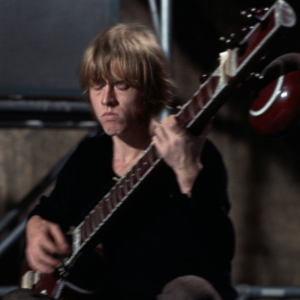Eddie Van Halen’s new take on a classic guitar first appeared on the cover of Van Halen’s iconic 1978 self-titled debut album. In the photo, 22-year-old Van Halen is lifting his guitar toward the camera, trailed by what appears to be an explosion—or eruption—of red-hot energy.
Videos by American Songwriter
Born Edward Lodewijk Van Halen in Amsterdam in 1955, he forever redefined rock guitar playing and subsequently reinvented the whole damn thing.
And the Cradle Will Rock …
Now widely copied, his legendary guitar formed from a $50 factory-second body and an $80 neck, each Fender-style part manufactured in 1975. Like a standard Stratocaster, the guitar body contained open slots to fit three single-coil pickups.
But Van Halen wanted more from his Stratocaster. He wanted the comfort of the Fender but the power of a Gibson Les Paul, which has a high-output humbucking pickup, as opposed to Fender’s single coil pickup design.
So, he began chiseling the guitar’s body to fit a Gibson-style humbucking pickup he’d removed from a semi-hollow body guitar. Van Halen wasn’t a skilled woodworker or electronics guru, and his dull-edged carving and rudimentary soldering abilities showed.
Traditionally, Gibson aligns the pickup parallel to the guitar’s bridge. But the string spacing on the Fender bridge he used then was too wide for the replacement pickup. To compensate, Van Halen rotated the pickup to accommodate the spacing—a technique that’s since become industry standard with many guitar builders.
Jump
To reduce feedback, Van Halen dipped the humbucking pickup into a coffee can full of paraffin wax. It’s the same wax used on surfboards. Other guitar companies like Fender and Rickenbacker had used similar techniques for controlling feedback.
To befuddle the copycats, he placed a pickup selector switch in the empty middle pickup position and a nonfunctioning pickup in the neck position.
While most guitar companies use lacquer on their necks, Van Halen left his unfinished because he preferred the quick feel. He also replaced the neck’s fret wire with larger frets.
He used Schwinn acrylic bicycle paint for the black and white-striped finish seen on the first Van Halen album cover. Furthermore, he cut and installed a black pickguard to cover the empty pickup slots. Eventually, he removed the pickguard. He installed a single master volume knob, though the knob he chose reads “Tone.”
The entire experiment cost less than $150 to build. Eventually, Van Halen repainted the guitar red and added more stripes. While on tour, he found orange and red truck reflectors and stuck them to the back of the instrument.
Loss of Control
Meanwhile, a new problem developed on the California band’s second world tour as Van Halen struggled to keep his guitar in tune. He discovered a solution using a prototype-locking tremolo system by Floyd Rose in Seattle. But that fix created a new problem. The new tremolo system didn’t fit properly, so he mounted a quarter beneath the Floyd Rose unit to secure it.
After Van Halen broke the original neck, a series of replacements followed. He used German-made Schaller tuners to stabilize the guitar’s intonation.
Somebody Get Me a Doctor
Mary Shelley’s 1818 novel follows Victor Frankenstein, a Swiss scientist who gives life to a creature using insight he’s learned observing the decay of living things.
Van Halen wasn’t quite meddling with nature, and his guitar—as far as we know—never tried exacting revenge on him, but he did experiment to break the limitations he observed on world-renowned instruments.
The guitar became known as “Frankenstein,” “Frankie,” and sometimes the “Frankenstrat.” Van Halen didn’t name the guitar, but it’s how fans referred to his iconic axe (’50s-era slang borrowed from the saxophone) over time.
Van Halen’s famous Frankenstein comprises multiple parts from various sources. At its core, the guitar is a souped-up Fender Stratocaster known for its classic design and ease of playability.
He combined the legendary sounds of Strat-era Eric Clapton and Les Paul-era Jimmy Page by mixing and matching their most desired parts.
Always his own man, Van Halen refused to accept the boundaries of the guitar regardless of what the preceding masters—Hendrix, Clapton, Page—had accomplished.
“Eruption”
When Van Halen unleashed “Eruption” in 1978, it became a rock ‘n’ roll Big Bang event. A new universe of rock guitar playing had exploded into existence. However, this Big Bang event resulted from an intelligent designer and merged experimentation, accident, and genius.
Eddie Van Halen’s revolutionary sound echoed Clapton, Page, and Mozart. Equally important is Van Halen’s reinvention of an existing guitar design. Generations of players copied Van Halen, and generations of guitar builders changed how they made the instrument.
The rock calendar now designates its epochs thusly: BVH and AVH.
When you purchase through links on our site, we may earn an affiliate commission.
Photo by Kevin Winter/Getty Images
